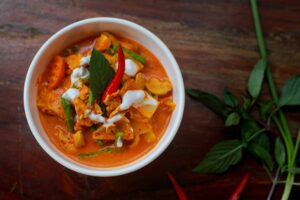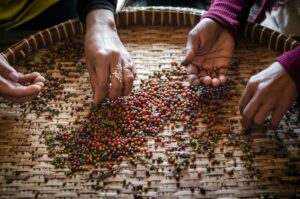• Trousers and jeans which can dry quickly • Casual dresses for the evening • Clothes which are helpful when it rains • Swimming things, sun hat • Underwear • T-shirts and shorts • Sweater/Jacket for winter • Hiking boots/trekking sandals (for trekking tour) • Socks • Rain coat
Flashlight • Travel clock • Sunglasses • Dry bag • Flip flops • Insect repellent • Shaving equipment • Sun cream (high factor), Lip cream • First aid kit • Pharmaceuticals /meds • Ear plugs • Eye cover
Cash (USD or Cambodian Riel) • Debit/Credit card • Printed flight tickets • Passport (at least 6 months valid since your arrival date) • Copies of your passport • Travel insurance documents
Khmer is the official language of Cambodia, although sometimes it’s just referred to as Cambodian. It’s spoken by over 90% of the country’s population.
In recent years, Cambodia has seen a rise in tourism which has led to an increase in the use of English.
While the locals in a small village might not understand you, you’ll be able to get by easily in the bigger towns and cities using English
Cambodia has a hot and humid tropical climate, is warm year round with temperatures rarely dipping below 20°C (between 23 C and 26 C at night, and 30 C to 35 C during the day)
There are two predominant seasons: dry and wet.
• The wet season, known locally as the green season, lasts from May to October and is marked by an afternoon downpour.
• The dry season lasts from November to March and is marked by hot and dry days.
Cambodia cuisine, especially street food is one thing that you can not miss. However, it is advised to enjoy at caution since your digestion system might not be able to handle all the strange new herbs and spices.
Cambodia food is famous for its rice and fishes. Average meal consists of more than one dish and ideally contrasts flavors, textures and temperatures within the meal using plenty of herbs, leaves, pickled vegetables, dipping sauces, edible flowers and other garnishes and condiments.
Here are just a few examples of the fantastic dishes you can expect to find in Cambodia:
Fish amok: a fish mousse with fresh coconut milk and kroeung, a type of Khmer curry paste made from lemongrass, turmeric root, garlic, shallots.

Khmer red curry: beef, chicken or fish, eggplant, green beans, potatoes, fresh coconut milk, lemongrass and kroeung.

Lap Khmer: beef salad features thinly sliced beef that is either quickly seared or “cooked” ceviche-style by marinating with lime juice.

Nom Bang Chok: a typical breakfast food, noodles laboriously pounded out of rice, topped with a fish-based green curry gravy made from lemongrass, turmeric root and kaffir lime.
Bai Sai Chrouk: rice dish with pork slices marinated in coconut milk or garlic slowly grilled over charcoal.
Red tree ants with beef and holy basil: rice dish with stir-fried red tree ants with beef and holy basil.
Cha Houy Teuk: a sweet jelly dessert made with agar agar, a gelatin that is derived from seaweed
Needless to say, Cambodia – as a tropical country – has a wealth of fresh fruits on daily offer. When you go to a local market you will be astounded by the beautiful colors and aromas, and – sometimes – the somewhat strange shape of the fruits. You can also let fruits mix into a smoothie, locally known as touk kolok. The country’s tropical fruits keep a court of their own; with the durian a revered king and the mangosteen an honored queen. To complete the royal fruit family, the lemut should be named prince and milk fruit bestowed the honor of princess.
Cambodia is a country that is awash with unique artisans recreating traditional art forms or putting their own modern spin on ancient techniques. The result is a plethora of souvenirs and memoirs to remind you of your trip. Here are a few things you can only get your hands on in the Kingdom of Wonder.
Krama: traditional scarf of the Cambodian

Cambodian Handicraft, Statues, Gemstone and artwork: The Cambodians are endowed with genuine skill of making handicraft and the ancient traditions were handed down from generation to generation. Delicate carvings, Buddha statues bas-reliefs, sapphires and rubies are available for tourists.

Kampot pepper: no reason to buy some pepper when you are on the land that produces one of the best peppers in the world. Grew throughout Kampot province, Kampot pepper is strong, delicate and aromatic thanks to the cool climate and quartz-rich soil.

Silverware: Cambodian silver jewellery doesn’t have high value as they are silver alloys with 70-80% silver but they are uniquely designed with beautiful Khmer patterns.

Tipping is not usual for in restaurants, bars etc. but may be appropriate if you feel that you have had excellent service from your guide (and/or driver). In this case the amount would be modest by US standards – the amount is up to you, here is our advise:
• For guide & Driver:
– Group 1-2 pax: 5 USD/day/group for driver – 10 USD/day/grp for guide
– Group 3-6 pax: 8 USD/day/grp for driver – 16 USD/day/grp for guide
– Group 7-10 pax: 10 USD/day/grp for driver – 20 USD/day/grp for guide
– Group 11 pax up: 1 USD /day per guest for driver – 2 USD/day per guest for guide
• For porter at hotel: 0,5 USD per guest
Unless your phone is locked with your simcard from your home country provider, it is very convenient to purchases and set up a Cambodia local simcard.
• You can do so at the airport on arrival or any provider retail shops.
• There are many service providers in Cambodia, but the one with best plans are Metfone, Smart or Cellcard.
• With only $10-$20, you will have a local number with 4G internet access for your holiday.

Cambodia is a Buddhist country, it is seen as inappropriate to dress in a provocative way, such as wear beach attire in the city.
When visiting pagodas as women shall choose conservative clothing, the less bare skin the better, and most importantly, no shorts, skirts, top with low neck lines.
Also, woman shall not touch the monks or hand any item directly at them.
Local time is GMT + 7 hours.
• Most government offices are open from 8:00 / 8:30 a.m. to 4:30 / 5:00 p.m., Monday through Friday, but are closed from 11:30 a.m. to 1:30 p.m. for lunch.
• Banks are closed after 4:00 p.m. Some foreign companies or private enterprises are open Saturday mornings. Most shops and department stores are open every day until 8.00 or 9.00 p.m.
The local currency is the Riel (abbreviated “r’’ or KHR). Bank notes are 100r, 200r, 500r, 1000r, 2000r, 5000r, 10,000r, 20,000r, 50,000r and 100,000r
• Visa, Master & JCB cards are widely accepted. Some merchants also accept AMEX. A 3% bank charge on transactions (4% for AMEX) is pretty common, due to bank policies.
• ATM facilities are readily available now in major cities.
• To exchange your money into KHR, you can go to any local gold/ jewelry store for the best rate available. However, if you want to feel more secured, going to the banks is an alternative options. Cambodia has many banks available, but for better exchange rate, we advise you to seek services from Acleda bank, Canadia bank, Foreign Trade Bank of Cambodia, Union Commercial Bank. (USD 1 ~ 4000r).
• However, it is advised that not to exchange USD into KHR since 90% of services are priced in KHR and USD, therefore you can pay with USD, and expect to get changes in either KHR or USD.
Your itinerary will not require you to take any anti-malarial medications. You should however take all possible care to not be bitten by mosquitoes even in the cities by making sure you apply a good repellant containing the chemical DEET before sunset and before your first bite everyday.
Anti malarial are only recommended for people staying for prolonged periods (>1 month) in high risk areas which are identified by Cambodia ministry of health.
Cambodia is a relatively safe country.
• Violent crimes are uncommon, however, assaults, robberies, and sexual harassments do occur rarely in the remote and poorly lit areas of big cities.
• The most frequent crimes against foreigners are purse snatching, pickpocketing, and others petty thefts. Renting and riding a bike you should be aware of the situations when criminals push the bike or the rider is struck by the thieves while the bike is being ridden. This kind of crime continues to be on the critical level and resistance is usually may turn violent.
• Armed robberies continued to be on a high level, so remember that no valuables is worth your life. Many of theses crimes are committed by young gangs operating particularly in Siem Reap. Evolving from a strictly cash society credit card cloning and skimming is on the rise. Thus keep an eye on your credit card while paying and don’t leave your card from the sight while paying at a restaurant or cafe.
In Cambodia the power sockets are of type A, C and D. The standard voltage is 230 V and the standard frequency is 50 Hz. If you have any devices needing a special outlet, please bring its adapter kit – The best investment is to buy a universal AC adapter (at the airport), which enables you to plug it into any outlet without damaging your appliances.
You can access the internet at hotels, cyber cafés & Internet/Computer Service Centers. ADSL technology is widely used in major cities. Also, WiFi internet is available at some cyber cafés, restaurants, and most hotels in major tourist destination.
A regular international postal service is available. Express Mail Service (EMS) is available to more than 50 countries worldwide with a delivery time of 2 to 10 days.
Cambodia has high international telephone charges. It is important to check the exact amount with the hotel before making a call, as hotel surcharges are often imposed. VOIP calls help reduce call charges.
Flight times may vary from day to day. Schedules are subject to change without prior notice. You should allow an hour (domestic) to 2 hours (international) at the airport for the check-in process prior to your flight departure.
Baggage allowance is 20kg per person in economy class. Hand luggage should not weigh more than 7kg.